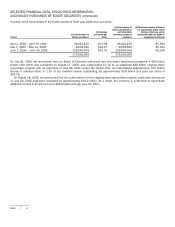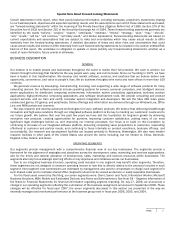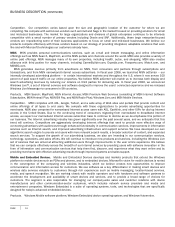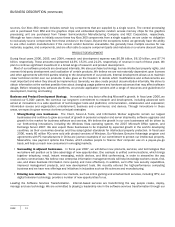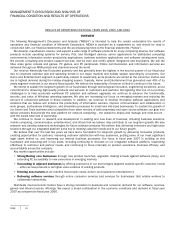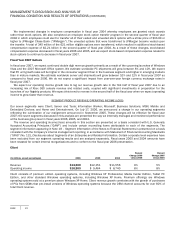Microsoft 2006 Annual Report Download - page 16
Download and view the complete annual report
Please find page 16 of the 2006 Microsoft annual report below. You can navigate through the pages in the report by either clicking on the pages listed below, or by using the keyword search tool below to find specific information within the annual report.
PAGE 15
compatible with other software and hardware. In recent years certain “open source” software business models have evolved
into a growing challenge to our license-based software model. Open source commonly refers to software whose source code is
subject to a license allowing it to be modified, combined with other software and redistributed, subject to restrictions set forth in
the license. A number of commercial firms compete with us using an open source business model by modifying and then
distributing open source software to end users at nominal cost and earning revenue on complementary services and products.
These firms do not have to bear the full costs of research and development for the software. A prominent example of open
source software is the Linux operating system. While we believe our products provide customers with significant advantages in
security and productivity, and generally have a lower total cost of ownership than open source software, the popularization of
the open source software model continues to pose a significant challenge to our business model, including continuing efforts by
proponents of open source software to convince governments worldwide to mandate the use of open source software in their
purchase and deployment of software products. To the extent open source software gains increasing market acceptance, sales
of our products may decline, we may have to reduce the prices we charge for our products, and revenue and operating margins
may consequently decline.
Another development is the software-as-a-service business model, by which companies provide applications, data, and
related services over the Internet. Providers use primarily advertising or subscription-based revenue models. Recent advances
in computing and communications technologies have made this model viable and enabled the rapid growth of some of our
competitors. We are devoting significant resources toward developing our own software-as-a-service strategies. It is uncertain
whether these strategies will prove successful.
We face intense competition. We continue to experience intense competition across all markets for our products and
services. Our competitors range in size from Fortune 100 companies to small, specialized single-product businesses and open
source community-based projects. While we believe the breadth of our businesses and product portfolio offers benefits to our
customers that are a competitive advantage, our competitors that are focused on a narrower product line may be more effective
in devoting technical, marketing, and financial resources to compete with us. In addition, barriers to entry in our businesses
generally are low. The Internet as a distribution channel and the non-commercial software model described above have reduced
barriers to entry even further. Open source software vendors are devoting considerable efforts to developing software that
mimics the features and functionality of our products. In response to competitive factors, we are developing versions of our
products with basic functionality that are sold at lower prices than the standard versions. These competitive pressures may
result in decreased sales volumes, price reductions, and/or increased operating costs, such as for marketing and sales
incentives, resulting in lower revenue, gross margins and operating income.
We may not be able to protect our intellectual property rights against piracy, infringement of our patents by third parties, or
declining legal protection for intellectual property. We defend our intellectual property rights and combat unlicensed
copying and use of software and intellectual property rights through a variety of techniques. Preventing unauthorized use or
infringement of our rights is difficult. Piracy of our products represents a loss of revenue to us. While this adversely affects U.S.
revenue, the impact on revenue from outside the United States is more significant, particularly in countries where laws are less
protective of intellectual property rights. Similarly, the absence of harmonized patent laws makes it more difficult to ensure
consistent respect for patent rights. Future legal changes could make this even more challenging. Throughout the world, we
actively educate consumers about the benefits of licensing genuine products and obtaining indemnification benefits for
intellectual property risks, and we educate lawmakers about the advantages of a business climate where intellectual property
rights are protected. However, continued educational and enforcement efforts may fail to enhance revenue. Reductions in the
legal protection for software intellectual property rights or compliance with additional intellectual property obligations impacting
the rights of software developers could both adversely affect revenue.
Third parties may claim we infringe their intellectual property rights. From time to time we receive notices from others
claiming we infringe their intellectual property rights. The number of these claims may grow. Responding to these claims may
require us to enter into royalty and licensing agreements on less favorable terms, require us to stop selling or to redesign
affected products, or to pay damages or to satisfy indemnification commitments with our customers including contractual
provisions under various license arrangements. If we are required to enter into such agreements or take such actions, our
operating margins may decline as a result. We have made and expect to continue making significant expenditures to settle
claims related to the use of technology and intellectual property rights as part of our strategy to manage this risk.



